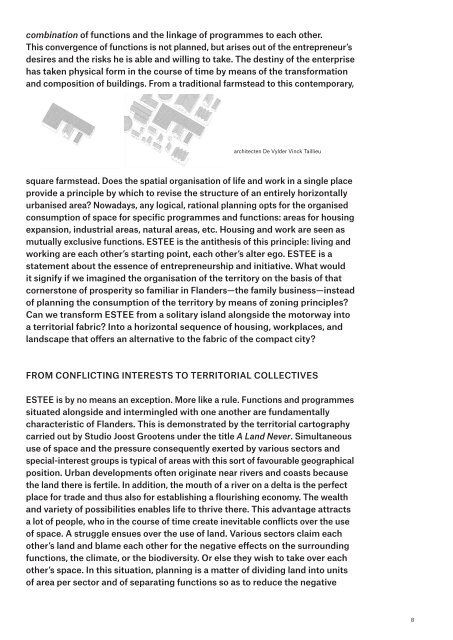The Ambition of the Territory Belgian Pavilion, 13th International Architecture Exhibition, La Biennale di Venezia 2012
Create successful ePaper yourself
Turn your PDF publications into a flip-book with our unique Google optimized e-Paper software.
combination <strong>of</strong> functions and <strong>the</strong> linkage <strong>of</strong> programmes to each o<strong>the</strong>r.<br />
This convergence <strong>of</strong> functions is not planned, but arises out <strong>of</strong> <strong>the</strong> entrepreneur’s<br />
desires and <strong>the</strong> risks he is able and willing to take. <strong>The</strong> destiny <strong>of</strong> <strong>the</strong> enterprise<br />
has taken physical form in <strong>the</strong> course <strong>of</strong> time by means <strong>of</strong> <strong>the</strong> transformation<br />
and composition <strong>of</strong> buil<strong>di</strong>ngs. From a tra<strong>di</strong>tional farmstead to this contemporary,<br />
architecten De Vylder Vinck Taillieu<br />
square farmstead. Does <strong>the</strong> spatial organisation <strong>of</strong> life and work in a single place<br />
provide a principle by which to revise <strong>the</strong> structure <strong>of</strong> an entirely horizontally<br />
urbanised area? Nowadays, any logical, rational planning opts for <strong>the</strong> organised<br />
consumption <strong>of</strong> space for specific programmes and functions: areas for housing<br />
expansion, industrial areas, natural areas, etc. Housing and work are seen as<br />
mutually exclusive functions. ESTEE is <strong>the</strong> anti<strong>the</strong>sis <strong>of</strong> this principle: living and<br />
working are each o<strong>the</strong>r’s starting point, each o<strong>the</strong>r’s alter ego. ESTEE is a<br />
statement about <strong>the</strong> essence <strong>of</strong> entrepreneurship and initiative. What would<br />
it signify if we imagined <strong>the</strong> organisation <strong>of</strong> <strong>the</strong> territory on <strong>the</strong> basis <strong>of</strong> that<br />
cornerstone <strong>of</strong> prosperity so familiar in Flanders—<strong>the</strong> family business—instead<br />
<strong>of</strong> planning <strong>the</strong> consumption <strong>of</strong> <strong>the</strong> territory by means <strong>of</strong> zoning principles?<br />
Can we transform ESTEE from a solitary island alongside <strong>the</strong> motorway into<br />
a territorial fabric? Into a horizontal sequence <strong>of</strong> housing, workplaces, and<br />
landscape that <strong>of</strong>fers an alternative to <strong>the</strong> fabric <strong>of</strong> <strong>the</strong> compact city?<br />
FROM CONFLICTING INTERESTS TO TERRITORIAL COLLECTIVES<br />
ESTEE is by no means an exception. More like a rule. Functions and programmes<br />
situated alongside and intermingled with one ano<strong>the</strong>r are fundamentally<br />
characteristic <strong>of</strong> Flanders. This is demonstrated by <strong>the</strong> territorial cartography<br />
carried out by Stu<strong>di</strong>o Joost Grootens under <strong>the</strong> title A <strong>La</strong>nd Never. Simultaneous<br />
use <strong>of</strong> space and <strong>the</strong> pressure consequently exerted by various sectors and<br />
special-interest groups is typical <strong>of</strong> areas with this sort <strong>of</strong> favourable geographical<br />
position. Urban developments <strong>of</strong>ten originate near rivers and coasts because<br />
<strong>the</strong> land <strong>the</strong>re is fertile. In ad<strong>di</strong>tion, <strong>the</strong> mouth <strong>of</strong> a river on a delta is <strong>the</strong> perfect<br />
place for trade and thus also for establishing a flourishing economy. <strong>The</strong> wealth<br />
and variety <strong>of</strong> possibilities enables life to thrive <strong>the</strong>re. This advantage attracts<br />
a lot <strong>of</strong> people, who in <strong>the</strong> course <strong>of</strong> time create inevitable conflicts over <strong>the</strong> use<br />
<strong>of</strong> space. A struggle ensues over <strong>the</strong> use <strong>of</strong> land. Various sectors claim each<br />
o<strong>the</strong>r’s land and blame each o<strong>the</strong>r for <strong>the</strong> negative effects on <strong>the</strong> surroun<strong>di</strong>ng<br />
functions, <strong>the</strong> climate, or <strong>the</strong> bio<strong>di</strong>versity. Or else <strong>the</strong>y wish to take over each<br />
o<strong>the</strong>r’s space. In this situation, planning is a matter <strong>of</strong> <strong>di</strong>vi<strong>di</strong>ng land into units<br />
<strong>of</strong> area per sector and <strong>of</strong> separating functions so as to reduce <strong>the</strong> negative<br />
8


















